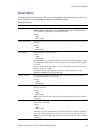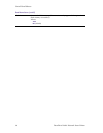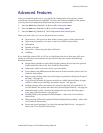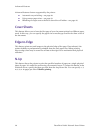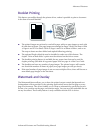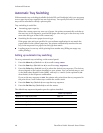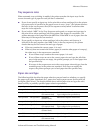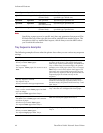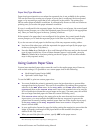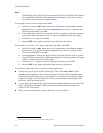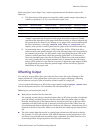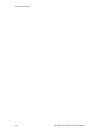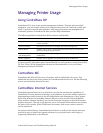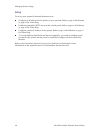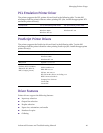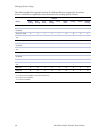
Advanced Features and Troubleshooting Manual 43
Advanced Features
Paper Size/Type Mismatch
Paper size/type mismatch occurs when the requested size is not available in the printer.
This can be caused by running out of paper in a tray that is configured for the requested
paper, or by requesting a paper that is not configured in the printer. The printer goes
off line under paper mismatch conditions. It automatically returns on-line and continues
printing once you resolve the paper mismatch condition.
If a tray is configured for the requested paper, but the tray is out of paper, the control panel
display screen prompts you to load the requested paper (size and type) in the appropriate
tray. Once you load the paper in the tray, printing continues.
If the request is for paper that is not configured in the printer, the control panel display
screen prompts you to load the requested paper in the first tray of the tray sequence.
If you do not want to load paper in the first tray of the tray sequence setting, either:
■ Load one of the other trays with the requested size paper and specify the paper type
in the tray (using the Tray Menu).
■ Press the Value keys (labeled 3 or 7) to scroll through all the trays and see the size and
type of paper in each tray. If one of these alternate papers is acceptable, press the
Enter key (labeled 4) to continue printing on the new paper. (You see the available
trays in tray sequence order.)
Using Custom Paper Sizes
Custom (non-standard) paper sizes cannot be used in the regular paper trays. However,
with certain settings, it is possible to use custom paper sizes in the following:
■ Multi-sheet Bypass Feeder (MBF)
■ Optional Custom Paper Tray
To use the MBF to print on custom paper sizes:
■ You must disable the printer’s automatic paper size jam detection to prevent false
messages from being reported. This can be accomplished by making the appropriate
selection in the MBF Size menu. In the Tray Menu, set the MBF Size menu item to
Custom and then set the Custom Size menu item to the standard size to be used by
PCL or PostScript to format the output image on the page.
*
(In most cases, this will be
the next larger standard paper size from the custom size being used.)
■ If the Custom Size setting is the same value as the auto-detected size in another
input source, you must exclude the MBF from the tray sequence (to prevent the
printer from incorrectly loading standard paper from one of the regular input trays).
In the Tray Menu, set the Tray Sequence menu item to Off or a sequence that
doesn’t include MBF.
■ In your application, format the page (including setting the margins) to ensure that the
image is properly positioned on the paper based on the standard size (that you
defined in the Tray menu).
*
■ When you send the job to the printer, specify MBF as the paper source.
* PCL and PostScript only format their output images to defined paper sizes.



